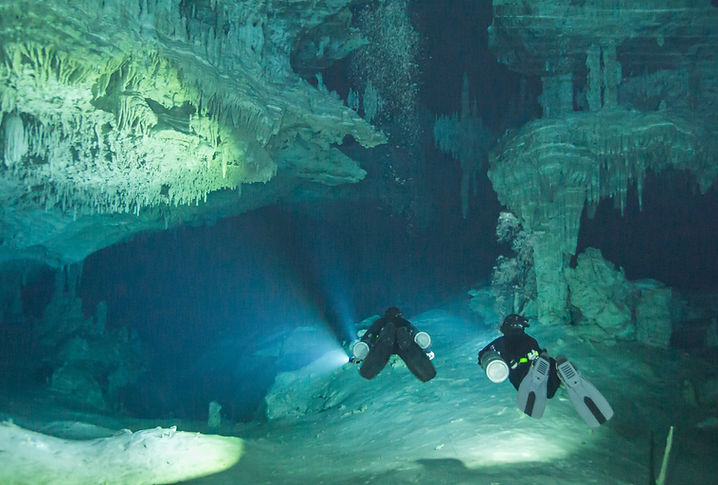
COURS TDI "INTRO TO CAVE"
DURÉE
3 jours
APERÇU RAPIDE
Le programme TDI Intro to Cave Diver est l'étape suivante après le cours Cavern Diver, se concentrant sur les techniques, procédures et protocoles pour des plongées en grotte en toute sécurité. Il met l'accent sur la gestion conservatrice des gaz et des distances de pénétration sûres, préparant les plongeurs à affronter de nouveaux défis.
En vous aventurant au-delà de la zone de lumière du jour et dans la grotte proprement dite, les compétences telles que le placement, le positionnement, la communication et la vigilance, prennent une signification plus profonde. Vous apprendrez à résoudre les problèmes "le long de la ligne" et à planifier des plongées plus complexes. Ce cours est un prérequis au cours Full Cave Diver.
En résumé, le cours TDI Intro to Cave Diver équipe les plongeurs de compétences et de connaissances avancées pour naviguer en toute sécurité et avec confiance dans les environnements souterrains, les préparant à des explorations aux limites étendues et à des formations plus avancées.
PRÉREQUIS
Les étudiants doivent avoir 18 ans et :
-
certifiés TDI Intro to Tech (ou équivalent ou expérience avérée), si le cours est pris en configuration backmount
-
certifiés TDI Sidemount (ou équivalent ou expérience avérée), si le cours est pris en configuration sidemount
-
certifiés TDI Nitrox (ou équivalent), car nous utilisons le Nitrox32 comme gaz standard
-
certifiés TDI Cavern (ou équivalent)
-
avoir un minimum de 50 plongées enregistrées
COMPÉTENCES ET NOUVEAUX DÉFIS
Le cours Intro to Cave Diver marque le passage du niveau caverne vers un véritable environnement sous plafond. Vous renforcerez vos acquis, affinerez vos techniques et développerez l’état d’esprit nécessaire pour progresser en sécurité dans la grotte.
Les plongées d’entraînement incluent :
-
Perfectionnement des compétences fondamentales en plongée.
-
Suivi d’un fil d’Ariane continu en équipe.
-
Communication avancée au sein de l’équipe.
-
Techniques de propulsion avancées pour un contrôle précis.
-
Communication par contact en faible ou en l'absence de visibilité.
-
Gestion des urgences déjà vues aux niveaux précédents, dans des conditions plus difficiles.
-
Procédures de fil rompu et de perte de fil.
-
Exercices de plongeur perdu et de séparation d’équipe.
Les exercices à terre couvrent :
-
Simulations de désorientation et d’intersections manquées.
-
Scénarios de perte ou de rupture de fil, et de plongeur perdu.
-
Exercices de séparation d’équipe.
-
Briefings et débriefings détaillés pour consolider chaque étape.
Les présentations théoriques et discussions abordent :
-
La gestion des gaz (règle des sixièmes, marges de sécurité).
-
Les types de grottes, l’étiquette et les considérations environnementales.
-
La vigilance face aux plafonds et fonds de grottes, et la prévention des pertes de visibilité.
-
Les défis psychologiques et physiologiques liés à des pénétrations plus longues.
-
La reconnaissance du stress, le contrôle de soi et la gestion de l’état d’esprit.
-
La conservation des grottes et une pratique responsable de la plongée souterraine.
Le défi de l’Intro to Cave Diver :
Plonger dans l’obscurité, sous plafond, exige une vigilance accrue, une flottabilité et une propulsion affinées, ainsi qu’un excellent travail d’équipe. Vous serez confronté à des risques de désorientation, de perte de visibilité et à la présence d’autres plongeurs et de leur matériel dans la grotte.
À l’issue de la formation, vous aurez acquis les compétences et la confiance nécessaires pour évoluer en sécurité dans ces environnements, tout en développant la conscience et l’état d’esprit requis pour progresser vers des niveaux plus avancés de plongée souterraine.





